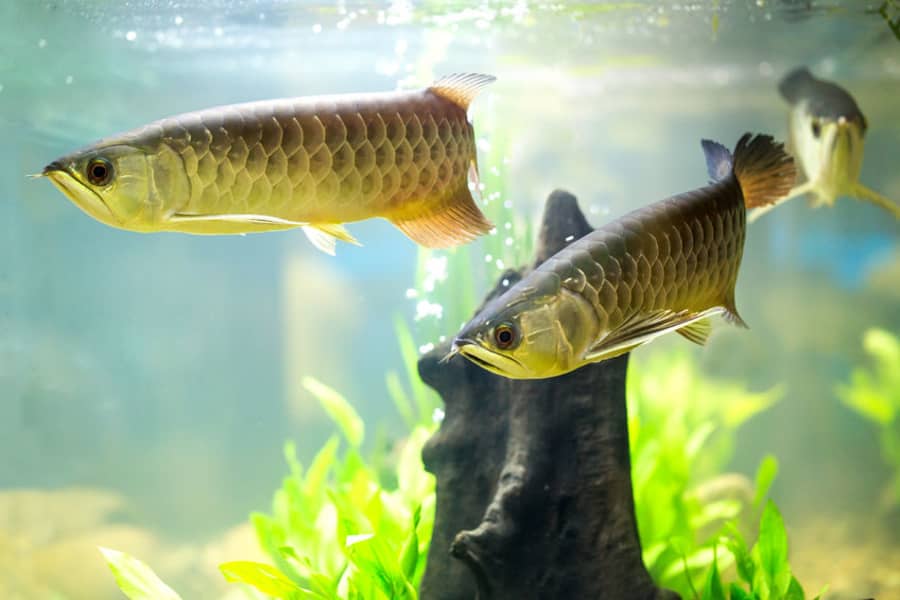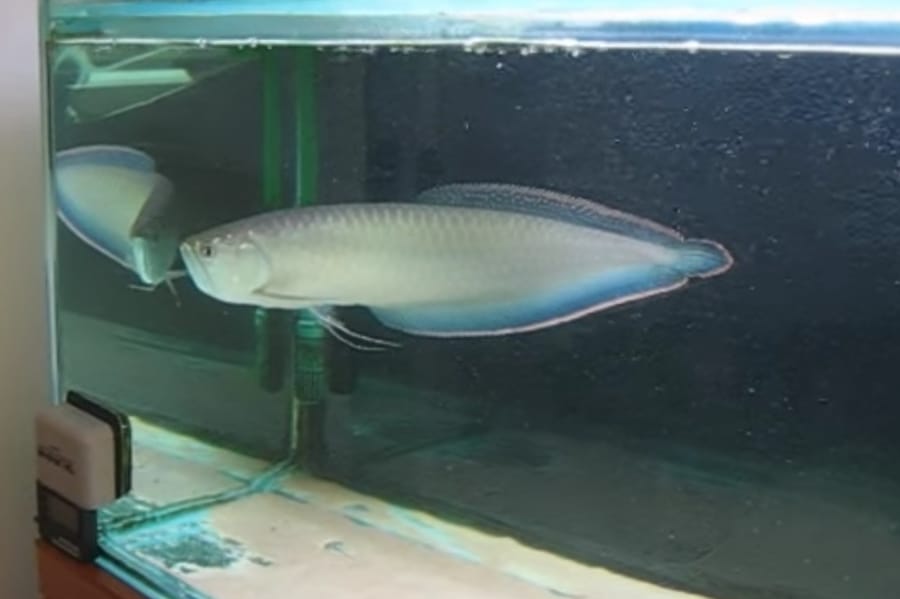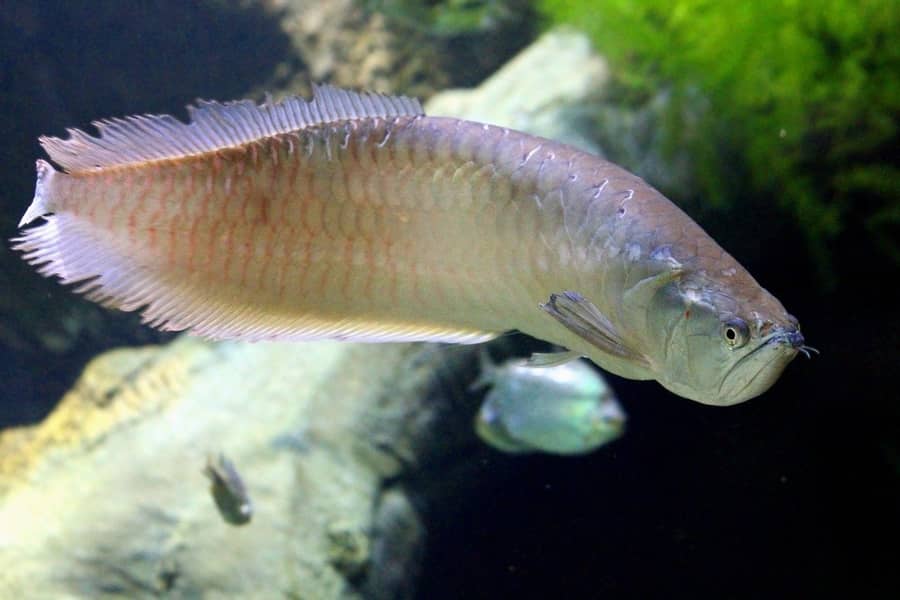Black Arowana Vs Silver Arowana: What Is The Difference Between Them?

Even though they require a lot of space, arowanas are a terrific addition to any experienced aquarium enthusiast’s collection. However, with so many different varieties and a wide range of color choices, it can be hard to choose which type to invest in. What differences even exist between the less expensive black and silver arowanas?
Black arowanas are not only darker in color but also smaller and grow slower, more aggressive, and can survive in colder temperatures. On the other hand, silver arowanas are lighter in color, the largest and most docile of all arowanas, more prone to drop eye, and can jump up to 6 feet (1.8 m).
In this article, we will explore these two varieties of arowana, including the general traits they have in common and their many differences. We will detail differences in appearance, size, feeding habits, aquarium needs, and behavior, among others.
Arowana: A General Overview
While there are many differences between black and silver arowanas, as members of the same species, they are more similar than different. To really understand these nuanced differences, it’s crucial to know the basic features that these unique fish share. Let’s take a closer look at the features all arowanas share.
Origins
If you’re interested in purchasing arowanas for your personal aquarium, it’s likely because you’ve seen this fascinating fish at a zoo or pet store in your local area. You can also see them on display in aquariums in many Asian restaurants.
Both black and silver arowanas are actually native to South America. These freshwater fish can also be found in ponds, lakes, flooded forests, and other bodies of water in Asia, Australia, and even near-equatorial regions of Africa.
Characteristics
Part of the Jurrasic family Osteoglossidae, arowanas are often called “bony tongue” fish. This is due to one of their most defining characteristics, a toothed bone that juts out from the lower part of their mouths.
They’re also characterized by the two distinct barbels or whiskery organs that hang from their lower jaw. Arowanas are generally fairly slim, which gives them an eel-like appearance, according to Biology Dictionary. Despite this, arowanas are extremely powerful.
Both black and silver arowanas benefit from the species’ unique mouths. All arowanas have large, upturned mouths. This allows them to breathe oxygen easily while near the water’s surface. It also makes it easier for them to catch any prey lingering on top of or near the water. These unique mouths, coupled with arowanas’ large eyes and extremely good eyesight, makes them feared predators in the water.
While this article will focus on black and silver arowanas, these fish actually appear in a wide range of stunning colors in the wild. From gold to blue to red, these fascinating fish put on a show with their colorful scales.
According to Pet Guide, arowana’s scales are organized in stunning mosaic patterns, which gives them a striking look. These scales are also incredibly heavy and can get up to two centimeters long, offering incredible protection from other fish.
Due to these scales, arowanas are often known as “dragon fish” in Asian countries. This is because these scales give the fish the appearance of the traditional Chinese dragon. Luckily, since these dragons are a sign of luck and good fortune in Chinese culture, arowanas have become known as lucky fish. This makes them even more desirable to have in any home aquarium.
Black Arowana Basics

Black arowanas are a great investment for any aquarium, with their beautiful scales and the rumored good luck they bring. However, if you’re considering purchasing a black arowana, you’ll want to be sure you’re fully committed.
In addition to being somewhat high maintenance, these fish also have a relatively long life span, with some arowanas making it to their twentieth birthdays. If you think you’re up for the challenge, keep reading to learn more about them.
Appearance
Even though their name may indicate otherwise, a black arowana is not completely black. While young black arowanas have a long black stripe running along the length of their bodies, this band fades to a purplish hue as they age.
Adult black arowanas actually look fairly similar to silver arowanas, with fins that fade from silver to black. You may even notice hints of pink, white, and orange near the edge of their fins. These colors make black arowanas quite beautiful overall.
Size
If you purchase your black arowana from an aquarium supply store, you’ll likely receive a fish around four inches (10.16 cm) in length. Since this arowana will be so small, it will likely have a yolk sac attached to provide nutrition.
Black arowanas grow slower and more steadily than silver arowanas, but that doesn’t mean they won’t be large. While most black arowanas grow to 30 inches (76.2 cm), some have been known to be almost 40 inches (101 cm) long!
Black arowanas are not light fish either, with average weights between 10 and 15 pounds (4.5 and 6.8 kgs). However, males are larger than females and have flowing crests that further differentiate them from females. You’ll have to wait to see these differences, as arowanas don’t reach sexual maturity for nearly five years.
Aquarium Needs
Since black arowanas are big fish, they need a big tank. Most sources recommend over 200 gallons (757 liters), while Aquarium Domain suggests a 300-gallon (1136-liter) tank with a minimum of 30 inches (76.8 cm) in width.
As you can imagine, an aquarium of this size costs quite a lot of money and takes up a lot of room. While you can always upgrade as your fish grow, be prepared to carve out significant room in both your house and your budget for this tank.
Once you’ve invested in the tank, you’ll also need to invest in aquarium accessories. It recommends laying gravel or sand along the bottom of the tank and including driftwood and other vegetation.
You’ll also need to invest in a strong filtration system, as black arowanas are high waste producers. Water should be kept as clean as possible, so you’ll likely need to do 25% water changes every other week as well.
While many power and canister filters will be strong enough to clean tanks of this size, it’s always good to keep an eye on nitrate and pH levels yourself. This highly-rated API Aquarium Test Kit from Amazon allows you to easily test your aquarium water for the most vital water parameters and contains enough testing materials to test weekly.
As mentioned previously, black arowanas are originally from warm climates. Accordingly, the water in their tank will need to be kept fairly warm. The ideal water temperature is between 75°F and 80°F (24°C and 27°C). However, there is evidence that black arowanas can survive colder water temperatures than their silver counterparts.
Behavior
As a whole, arowanas are relatively aggressive and territorial fish. Black and silver arowanas are actually the least aggressive of their species, although they are still fairly territorial. Black arowanas are reported to be slightly more aggressive than silver arowanas, so keep this in mind when stocking your home aquarium.
Most aquarium enthusiasts recommend not keeping more than one arowana in the same tank, as they have been known to attack their own species.
If you raise your arowanas together from infancy, it may be possible to have more than one in your tank. Otherwise, they will likely see a new arowana as an intruder and respond aggressively. However, arowanas are much less likely to attack other species.
Good tankmates include:
- Peacock bass
- Lima Shovelnose catfish
- Large Oscar fish
- Clown Loaches
- Freshwater Stingray
Parrot Cichlids - Knife fish
- Tinfoil Barb
Feeding Habits
Like all arowanas, black arowanas are carnivores. In the wild, they’re constantly eating small fish and insects and maintain a high-protein diet. While they’re not incredibly picky about what type of prey you feed them, they prefer live prey.
As they get older and require larger prey, you can slowly train them to accept non-live options, like frozen shrimp and shellfish. It’s likely that they’ll never enjoy fish pellets, especially if they’re wild-caught.
Breeding
Breeding black arowanas in an aquarium is incredibly difficult, seeing as it’s not recommended to have more than one in a tank at a time.
Like all other arowanas, black arowanas are mouthbrooders—which is actually common in fish. This means that once the female lays eggs, the male fish incubates them in his mouth for about a month. Once the eggs hatch, the tiny fish continue to live inside the male’s mouth for the first two or three months of their lives.
Silver Arowana Basics

Now that we’ve looked at the black arowana, let’s explore its close relative, the silver arowana. If you’ve seen an arowana in an aquarium, you likely saw a silver arowana. These are the most common types of arowana, probably because they are the least expensive.
Nonetheless, they share many basic traits with black arowanas, including their long lifetimes. Despite this, there are some significant differences between these two types of fish.
Appearance
Like black arowanas, silver arowanas shift color as they age. According to the National Zoo, Juvenile silver arowanas have blue glints, but their scales transition to pearly silver over time.
This metallic silver color is the silver arowana’s trademark. These scales can sometimes shift to blue, red, and green as the arowana ages. In a dark tank full of bright-colored fish, the contrast of this nearly-white fish is especially beautiful.
Size
Silver arowanas are the largest of the arowana fish. In the wild, they often grow up to four feet (1.2 m). However, in an aquarium, the average size is around three and a half feet (1.07 m). While they’re in the same weight range as black arowanas (10-15 lbs), they’re more likely to be on the heavier side. They also grow faster than their black counterparts, averaging about two inches (5 cm) a month.
As with black arowanas, silver arowanas display sexual dimorphism—the difference in form between males and females in a species. Although silver arowanas are relatively slim fish, females are notably thicker than males. In addition to being slenderer, males also have a longer anal fin.
Drop Eye
Unfortunately, the Arowana family is prone to a condition called drop eye, defined by the Aquarium Wiki as when a fish’s eye bulges out and starts to point downward as if the fish was constantly looking at the bottom of the tank. Drop eye is most commonly seen in silver arowanas, according to Yi Hu Farm Fish Trading.
Silver arowanas may be at risk for several reasons, including their diet and tendency to jump, which we’ll talk about next. Unfortunately, there isn’t any known cure for drop eye. While veterinarians may be able to remove fatty tissue impeding vision, they cannot bring the eye back to its normal position.
Behavior
While all arowanas have a tendency to jump, this is especially prevalent in silver arowanas. Arowanas can jump up to six feet (1.8 m) out of the water to catch prey. In fact, they’ve been known to snatch reptiles and birds from branches of nearby trees. The silver arowana has even been given the nicknames “monkey fish” and “silver monkey” for its daring acrobatic displays.
Away from the wild, they are most likely to jump when placed in an aquarium too small for them or moved to a new space. If the aquarium is covered, they will still try to jump and hit their heads on the lid. This frequent battering of their heads is suspected to be a cause of drop eye.
Even though these fish are always in motion, silver arowanas are actually the most docile of all arowanas. They’re somewhat skittish and will swim away or try to hide if they’re approached too quickly, or a light is suddenly turned on. They are still territorial and should not be kept with other arowanas.
Any of the following animals as good tank mates for silver arowanas:
- Tiger Datnoid
- Common Pleco
- Snakehead fish
- Iridescent shark
- Flying Fox fish
- Silver Dollar fish
- Green Terror cichlid
Aquarium Needs
Like with black arowanas, you need to ensure that you have a large enough tank for your silver arowana. A minimum of 240 gallons (908 liters) is recommended, but bigger is always better with these large fish.
You’ll also want to keep in mind the space needed to house a large fish when adding plants and other accessories to the aquarium. Silver arowanas don’t really need any plants or decorations, and adding in too much takes valuable swimming space away from them.
As mentioned previously, silver arowanas are huge jumpers and need a tank that reflects that. This means purchasing a tank that is not only large enough but also thick enough to withstand a powerful fish hitting against it.
ModestFish states that arowanas can break glass less than a half-inch (1.27-cm) thick, so a sturdy tank is a must. You’ll also want to make sure that the tank is on a strong stand that won’t move with any bumps inside the tank.
The most important is making sure your tank has a strong lid with no gaps. Without a reliable lid, you might come home one day to find your silver arowana has jumped straight out of the tank onto the floor. You can also combat jumping by putting your tank in a low traffic area, as this minimizes the opportunities for your fish to get scared and jump out in a panic.
Feeding Habits
Silver arowana’s feeding habits are not too different from black arowanas. They are carnivores that prefer live prey but have been known to be occasional omnivores. Their favorite food is still small fish, as well as crustaceans.
Silver arowanas are surface feeders, which means they will swim right below the water line to catch their prey. While this may be slightly different when they’re not in the wild, it’s still their preferred way to enjoy a meal.
Breeding
Silver arowanas are mouthbrooders, as explained previously in this article. Also, like black arowanas, it’s difficult to get these fish to breed in captivity.
However, it is possible but usually in tanks over 500 gallons (1893 liters)—which is quite large to have in your home. It’s a gradual process, as arowanas have notoriously long courting periods. Using a tank divider will allow fish to become comfortable with each other before adding them to the same tank.
Conclusion
While black and silver arowanas have a lot in common, they are still totally different fish. From differences in temperament and behavior to size and appearance, you’ll need to keep all of these factors in mind before choosing one of these fish to add to your aquarium.
Regardless of whether you choose a silver or black arowana, it’s crucial that you invest in the proper tank and commit to a feeding and maintenance schedule in order to give these fish the best life possible.
